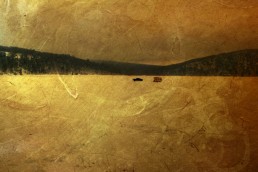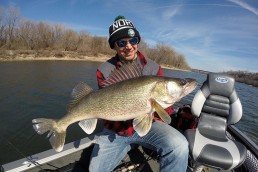Finesse Tactics for Leech Lake ‘Eyes
SHARE THIS POST
Tap more walleyes with a simple presentation
To be fair, August gets a bad rap. For most anglers, it’s simply a transition month we put up with—a chapter between the hot summer walleye action in July and the start of the early fall patterns in September. Some don’t even fish walleyes during the dog days, slinging treble-studded 2x4s to muskies or chasing bass in the cheese instead. The fair-weather crowd doesn’t even leave the dock, turning their energies to deer property or honey-do lists.
Too bad for them.
The fact is, now is actually a great time to catch walleyes. The sustained summer heat of August kicks the walleye’s metabolism into overdrive and it is forced to eat and eat—the same reason muskie anglers love August. As fish eat more, there’s simply a better chance for more bites, pure and simple.
Sure, now is a great period for trolling ‘crawler harnesses on bottom-bouncers or crankbaits on leadcore along deeper breaks and over main-lake humps, islands and points. And, nighttime is often the right time in August, when long-lining cranks over shallower flats—especially just before, during, and after the full moon—can fill a boxful of fish pretty quick.
So, while bottom-bouncers and night long-lining both catch ‘eyes this month, I prefer to do other things and fish lighter presentations wherever possible.
Fish like a kid
This August, I challenge you to fish like you did as a kid. What I mean by that is leave the bottom-bouncers, planer boards and leadcore in the rod lockers—stuff we weren’t using when we first started fishing. Well, maybe some kids are using these now, but you get my drift. Instead, grab a handful of 1/8-, 3/16- and 1/4-ounce jig heads, some curly-tail grubs and paddle tails, hairpin spinners and hit the water. Some small leeches, fatheads and ‘crawlers aren’t a bad idea, either.
The system is simple: Attach a clip-on hairpin spinner to your favorite jig head, thread on a plastic and start trolling. Fact is, the clip-on hairpin spinner is probably the most overlooked piece of tackle in our boxes, yet turns any jig head, curly-tail grub or paddle tail into a multi-species-catching machine.
I use Northland Thumper, Whistler or RZ jigs with a 2- to 2 1/2-inch Impulse curly tail or a slightly larger paddle tail. White, FireTiger, Perch and Crawfish colors are typical producers with these brands. I probably fish the White more than anything else. Fish it on a medium-light, 6-foot 3-inch up to 7-foot spinning rod and you’re in for some serious fun, even with “eater” walleyes. As far as line, I use Sunline SX1 10-pound-test green braid. You can use a fluorocarbon shock leader if you’re trolling in open water, but for our purposes there’s no need for it when trolling in and out of the weedy matrix. These fish are not line-shy.
Are you enjoying this post?
You can be among the first to get the latest info on where to go, what to use and how to use it!
It’s far from tournament rocket science, but it’s deadly on waters across the walleye belt—and river anglers know that. But we lake guys have overlooked the hairpin/plastic combo for far too long; let’s bring it back. It’s sort of like digging our your old LPs and jamming to Led Zeppelin or the Stones.
Where to fish it
On Leech Lake, I’m ditching deeper humps in favor of the weed edges, weed tops (cabbage and coontail), sand grass flats and weed/rock transitions. Although it’s August, there are still fish there, and often lots of them even if the crowd is fishing much deeper. Keep in mind walleyes are going wherever there’s food and shallower and mid-depth locations with weeds.
How to fish it
Get the boat up to 1 to 1.2 mph, cast the hairpin spinner and plastic combo behind the boat and start covering water. I like to identify a target depth range with the LakeMaster Depth Highlight on my Humminbird sonar. This feature can make a difference in your effectiveness. For example, in choosing 10 feet, plus or minus 2 feet, everything between 8 and 12 feet shows up in green. Then, it’s as simple as watching my map in split-screen with 2D sonar on the other side. Stay in green and you’re good. Monitor the 2D for weeds. Then, when you get a fish, drop a waypoint.
Depending on depth—from 4 to 15 feet—let more or less line out. The beauty of the hairpin spinner (especially on braid) is that it’s practically weedless. Tickle the weed tops, and if you do get hung up on a weed, rip the rod tip forward. Often, a walleye will smash the bait immediately after. If you’re fishing on the tail end of a cold front or a foul-weather scenario, consider slowing your troll to .9 mph. Even at that speed, you should get some loft from a 1/8- or 3/8-ounce jig with a spinnerblade when trolling in 8 to 10 feet. Keep in mind that in weedy or rocky areas, walleyes will swim up a few feet to hit a presentation; you don’t have to be near the bottom. In these same post-frontal conditions, you can add scent to the equation to up your odds. A fathead, half-‘crawler or small leech often works wonders.
Stop and pitch
The nice thing about trolling the hairpin spinner combo—as opposed to a spinner harness—is that when you catch a fish, you can immediately pitch back to the area. At 1.2 mph, you have plenty of time to get right back in the zone without having to turn your boat around, so you can cover an area faster and more effectively. In these areas now, where there’s one walleye, there’s typically a pod of several more, even sometimes a large school. I can’t tell you how many times I’ve stopped the boat, hit the button on my Minn Kota Talon and whacked fish for an hour or so with clients. It’s simply a matter of casting the bait out, counting down until you hit the bottom and slow-trolling back to the boat.
Low-impact fishing
The hairpin combo is a great presentation for anglers of all levels. From kids to the elderly, it’s really low- impact. The chances of getting hooked is minimal, unlike tossing or trolling cranks, and it’s not hard on your body, as when pulling heavy bottom-bouncers. Anyone who’s had shoulder or wrist issues can tell you that bottom-bouncers aren’t much fun. This system is light and easy to hang onto. You can drag it, jig it, cast it and you can feel the bite and you actually set the hook. It’s really hand-to-fin combat with walleyes in the middle of the summer. Sure there are times when we still use bottom-bouncers and harnesses for control, but simple jig heads on hairpin spinners work really well. Just ask my clients.
Now get out there and fish like a kid.
Brian “Bro” Brosdahl is a nationally known fishing guide and lead spokesman for many of the top companies in ice fishing. He can be contacted at bbro@paulbunyan.net or through his website at brosguideservice.com. Follow him on Instagram, Twitter and Facebook.
MWO
SHARE THIS POST
Did you enjoy this post?
You can be among the first to get the latest info on where to go, what to use and how to use it!
Brian 'Bro' Brosdahl
Outdoor communicator Brian “Bro” Brosdahl lives in northern Minnesota. He is a walleye guide in the Cass Lake, Leech Lake and Lake Winnibigoshish areas. He is sponsored by Northland Fishing Tackle, Frabill/Plano, Aqua-Vu, Humminbird/Minn Kota, St. Croix Rods, Ranger Boats, and Evinrude. Guide inquiries: brosguideservice.com. Follow on social media.




fairly new to fishing what is a hairpin spinner
Thanks for your question. We contacted Bro, who says another name for a hairpin spinner is a clip-on jig spinner, which turns your jig into a spinner bait. Instead of being shaped like an “L” it’s straight like an in-line Mepps spinner. It is also sometimes called a safety pin spinner. Hope this answers your question, and good fishing!